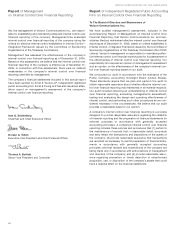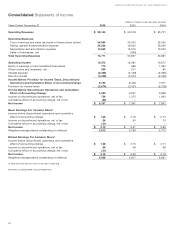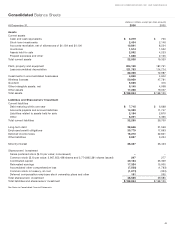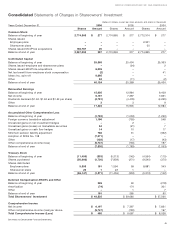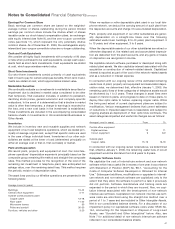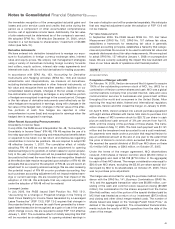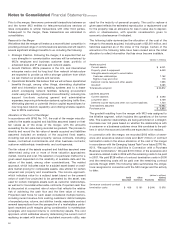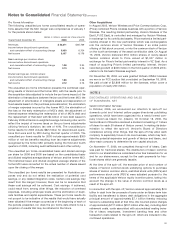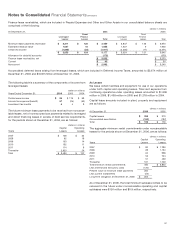Verizon Wireless 2006 Annual Report Download - page 52
Download and view the complete annual report
Please find page 52 of the 2006 Verizon Wireless annual report below. You can navigate through the pages in the report by either clicking on the pages listed below, or by using the keyword search tool below to find specific information within the annual report.
50
Prior to the merger, there were commercial transactions between us
and the former MCI entities for telecommunications services at
rates comparable to similar transactions with other third parties.
Subsequent to the merger, these transactions are eliminated in
consolidation.
Reasons for the Merger
We believe that the merger will make us a more efficient competitor in
providing a broad range of communications services and will result in
several significant strategic benefits to us, including the following:
•Strategic Position. Following the merger, it is expected that our
core strengths in communication services will be enhanced by
MCI’s employee and business customer base, portfolio of
advanced data and IP services and network assets.
•Growth Platform. MCI’s presence in the U.S. and international
enterprise sector and its long haul fiber network infrastructure
are expected to provide us with a stronger platform from which
we can market our products and services.
•Operational Benefits. We believe that we will achieve operational
benefits through, among other things, eliminating duplicative
staff and information and operating systems and to a lesser
extent overlapping network facilities; reducing procurement
costs; using the existing networks more efficiently; reducing line
support functions; reducing general and administrative
expenses; improving information systems; optimizing traffic flow;
eliminating planned or potential Verizon capital expenditures for
new long-haul network capability; and offering wireless capabili-
ties to MCI’s customers.
Allocation of the Cost of the Merger
In accordance with SFAS No. 141, the cost of the merger was allo-
cated to the assets acquired and liabilities assumed based on their
fair values as of the close of the merger, with the amounts
exceeding the fair value being recorded as goodwill. The process to
identify and record the fair value of assets acquired and liabilities
assumed included an analysis of the acquired fixed assets,
including real and personal property; various contracts, including
leases, contractual commitments, and other business contracts;
customer relationships; investments; and contingencies.
The fair values of the assets acquired and liabilities assumed were
determined using one or more of three valuation approaches:
market, income and cost. The selection of a particular method for a
given asset depended on the reliability of available data and the
nature of the asset, among other considerations. The market
approach, which indicates value for a subject asset based on avail-
able market pricing for comparable assets, was utilized for certain
acquired real property and investments. The income approach,
which indicates value for a subject asset based on the present
value of cash flow projected to be generated by the asset, was
used for certain intangible assets such as customer relationships,
as well as for favorable/unfavorable contracts. Projected cash flow
is discounted at a required rate of return that reflects the relative
risk of achieving the cash flow and the time value of money.
Projected cash flows for each asset considered multiple factors,
including current revenue from existing customers; distinct analysis
of expected price, volume, and attrition trends; reasonable contract
renewal assumptions from the perspective of a marketplace partic-
ipant; expected profit margins giving consideration to marketplace
synergies; and required returns to contributory assets. The cost
approach, which estimates value by determining the current cost of
replacing an asset with another of equivalent economic utility, was
used for the majority of personal property. The cost to replace a
given asset reflects the estimated reproduction or replacement cost
for the property, less an allowance for loss in value due to depreci-
ation or obsolescence, with specific consideration given to
economic obsolescence if indicated.
The following table summarizes the allocation of the cost of the
merger to the assets acquired, including cash of $2,361 million, and
liabilities assumed as of the close of the merger. Certain of the
amounts in the following table have been revised since the initial
allocation to reflect information that has since become available.
(dollars in millions)
Assets acquired
Current assets $ 6,001
Property, plant & equipment 6,453
Intangible assets subject to amortization
Customer relationships 1,162
Rights of way and other 176
Deferred income taxes and other assets 1,995
Goodwill 5,085
Total assets acquired $ 20,872
Liabilities assumed
Current liabilities $ 6,093
Long-term debt 6,169
Deferred income taxes and other non-current liabilities 1,720
Total liabilities assumed 13,982
Purchase price $ 6,890
The goodwill resulting from the merger with MCI was assigned to
the Wireline segment, which includes the operations of the former
MCI. The customer relationships are being amortized on a straight-
line basis over 3-8 years based on whether the relationship is with
a consumer or a business customer since this correlates to the pat-
tern in which the economic benefits are expected to be realized.
In connection with the merger, we recorded $193 million of sever-
ance and severance-related costs and $427 million of contract
termination costs in the above allocation of the cost of the merger
in accordance with the Emerging Issues Task Force Issue (EITF) No.
95-3, “Recognition of Liabilities in Connection with a Purchase
Business Combination.” We paid $116 million of the severance and
severance-related costs in 2006 with the remaining costs to be paid
in 2007. We paid $128 million of contract termination costs in 2006
and the remaining costs will be paid over the remaining contract
periods through 2009. The following table summarizes the obliga-
tions recognized in connection with the MCI merger and the activity
to date:
(dollars in millions)
Initial Other Ending
Allocation Increases Payments Balance
Severance costs and contract
termination costs $ 459 $ 161 $ (244) $ 376
Notes to Consolidated Financial Statements continued


